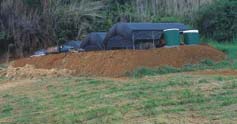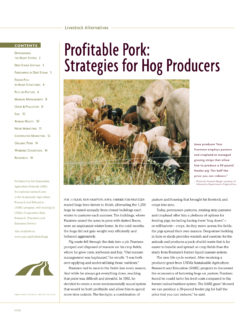by Barb Baylor Anderson

Producers in Hawaii are exploring a different approach to manure and nutrient management that employs a dry litter technology. The system, imported from land-limited countries like the Netherlands, Japan and Taiwan, could help producers effectively manage livestock waste, especially since Hawaii producers contend with more expensive land and bedding costs. Moreover, Hawaiians face truly unique ecological issues.
'Animal manure can be processed and developed as a marketable organic soil amendment for the agricultural, garden and landscape industries,' reports researcher Glen Fukumoto with the University of Hawaii Cooperative Extension Service. 'The interest in organic products is creating opportunities for innovators of nutrient management.'
Dry litter systems must be adapted to work in the tropics because excessive heat, disease and parasite build-up in litter are common. With funding from SARE, university researchers have worked to adapt the dry litter system to the state. The work began with a demonstration on an intensive 10-acre pig farm/ orchard and market garden at 1,600 feet altitude. There, the lava is thinly covered with erodible soil that has low nitrogen and organic matter content and could benefit from nutrient-rich compost.
The modified dry litter system that has evolved from the research combines animal manure with shredded green residue from orchards, market gardens and landscape operations to produce compost. Dry litter systems also reduce or prevent non-point source pollution by eliminating the use of water to clean hog production facilities.
'Elimination of water in the system removes the possibility of pollution from various components of a typical confined feeding operation waste management system,' said Fukumoto.
The key to the system is sloping pen floors that through a pig's hoof action propel the litter material out of the pen and into a holding trench. The carbon-nutrient mix flows out of the pens, and the separate composting trench keeps hogs from exposure to pre-compost material, where diseases and parasites may develop. This separation is the key difference in the modified design. Masazo's Pig Farm on the southern point of the Big Island of Hawaii has used the modified dry litter system since 1996 to collect and compost manure from 30 to 40 sows.
Masazo's owners, Dane and Terri Shibuya, constructed a modified greenhouse structure with two sets of pens for sows in different reproductive stages. Their system, which contains no mechanical parts or specialized equipment, provides cover and protection for the animals while collecting manure in a pit. After mixing the manure with carbonaceous material, they spread the compost on bananas, ti leaves and taro in their fields.
Cost analysis shows initial construction at approximately one-fourth the cost of a typical system in Hawaii. In addition, dry litter systems have lower operational, maintenance, labor and water costs, and may avoid potential water pollution fines and legal costs emanating from odor complaints.
One of the greatest benefits is the potential for economic return from the compost. When the litter compost was applied to market garden bananas in the initial demonstration, for example, researchers measured savings of $201 per acre.
'The modified dry litter system concepts may be adapted to larger, temperate ecosystems utilizing the hoop-type structures,' said Fukumoto. 'The dynamic flow of animal and green waste streams eliminates composting heat in pens and reduces exposure to disease and parasites. Ultimately, the value-added nutrients generate either a new revenue stream or fertilizer savings for the integrated farm.'
